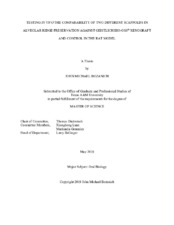| dc.description.abstract | .
Aim: Ridge preservation is a common procedure performed in Periodontics to prevent ridge resorption following tooth extraction. The aim of this present investigation is to compare in vivo the use of bioengineered Polycaprolactone (Polydopamine Coated and Uncoated) scaffolds against a commonly used xenograft, Bio-Oss@, and Control (no material) in ridge preservation procedures following first molar extraction in the rat model.
Materials and Methods: 33 male Sprague Dawley rats were used in the study. The maxillary right and left first molars were extracted and a standardized defect was created in the extraction socket using a slow speed handpiece and a #703 fissure bur. The rats were equally divided and randomly selected to receive one of four ridge preservation materials: Control (no material), Bio-Oss@, Polycaprolactone (Polydopamine Coated) scaffold, or Polycaprolactone (Uncoated) scaffold. All extraction sites were covered by a resorbable collagen membrane. Rats were randomly allocated to either be in the four week or eight week experimental groups. The rats were sacrificed, and the maxillae were dissected and hemisected into right and left halves. The tissues were processed and analyzed.
Results: In comparing radiographs, at 4 weeks, the difference in average bone height at extraction sockets was not statistically significant (p > 0.05) for any of the materials tested. At 8 weeks, the difference in average bone height at extraction sockets was statistically significant (p < 0.05) between Control and Bio-Oss@, Polycaprolactone (Uncoated), and Polycaprolactone (Polydopamine Coated). Micro-CT analysis revealed greater bone fill in the extraction sockets in the 8-week samples compared with the 4-week samples, and all samples showed a loss of residual bone height. Paraffin sections demonstrated that Control, Bio-Oss@, and Polycaprolactone (Uncoated) healed by direct ossification while Polycaprolactone (Polydopamine Coated) healed by endochondral ossification. New mineralized tissue formation was seen inside the fibrous connective tissue in all 8-week ground section samples.
Conclusion: Both Polycaprolactone (Polydopamine Coated and Uncoated) scaffolds performed comparably to Bio-Oss@ as a ridge preservation material over the Control (no material). Though new bone formation was seen with all treatment modalities, there was an improvement seen in using grafts over not using a graft. | en |


